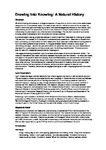Drawing into Knowing: A Natural History
| dc.contributor.author | Black, Stephanie | |
| dc.contributor.author | Imperatore, L | |
| dc.date.accessioned | 2018-04-23T16:06:23Z | |
| dc.date.available | 2018-04-23T16:06:23Z | |
| dc.date.issued | 2012-09 | |
| dc.identifier.uri | http://hdl.handle.net/10026.1/11333 | |
| dc.description.abstract |
Co-presentation w/ Lynn Imperatore. ABSTRACT Whether drawing commences in strategic suspension of cognition or from a posture that seeks deeper recognition of the considered object, this research pair share a method of practice that employs the drawn line to trace paths commencing outward from acknowledged deficiencies of information. Both view drawing as tool for exploration; a kind of raw material of thought-made-visible in marks that nibble away at preconception and other barriers to knowledge. The resultant records of such active thinking reveal discoveries to both the artists and a wider audience. A practice-based drawing project was devised in order to examine these ideas of drawing-as-process. The results of this project form the basis of a conversational presentation. Openness to the evolution within a drawing is a vital criteria for both researchers. Such openness invites detours and digressions that circumvent predetermined outcome. In the gaps between hesitant marks on blank paper - or obfuscating smudges - we chance upon what we do not yet know, what requires us as researchers to step back from preconception and focus anew upon the shifting object/subject. Thus we come to identify new and unexpected possibilities for investigation. The stages of drawing are evident upon its surface, where layers of error and hesitation collect. The materials themselves also reveal oscillation between the known and the unknown Ð as when pen bleeds into paper in the pause to look more closely. Such stratified disclosure is less common within written text. Hence drawing transcribes thought and insight of a distinctly different quality than those which occur when writing. The confidence and uncertainty that coexist in drawing allow us to reconsider notions of clarity and assumptions of outcome, particularly when applied to research and communication. Therefore, we situate and engage drawing as its own uniquely generative instrument of enquiry. | |
| dc.language.iso | en | |
| dc.rights | Attribution-NonCommercial-ShareAlike 4.0 International | |
| dc.rights | Attribution-NonCommercial-ShareAlike 4.0 International | |
| dc.rights | Attribution-NonCommercial-ShareAlike 4.0 International | |
| dc.rights | Attribution-NonCommercial-ShareAlike 4.0 International | |
| dc.rights.uri | http://creativecommons.org/licenses/by-nc-sa/4.0/ | |
| dc.rights.uri | http://creativecommons.org/licenses/by-nc-sa/4.0/ | |
| dc.rights.uri | http://creativecommons.org/licenses/by-nc-sa/4.0/ | |
| dc.rights.uri | http://creativecommons.org/licenses/by-nc-sa/4.0/ | |
| dc.title | Drawing into Knowing: A Natural History | |
| dc.type | conference | |
| plymouth.organisational-group | /Plymouth | |
| plymouth.organisational-group | /Plymouth/Faculty of Arts, Humanities and Business | |
| plymouth.organisational-group | /Plymouth/REF 2021 Researchers by UoA | |
| plymouth.organisational-group | /Plymouth/REF 2021 Researchers by UoA/UoA32 Art and Design: History, Practice and Theory | |
| plymouth.organisational-group | /Plymouth/Users by role | |
| plymouth.organisational-group | /Plymouth/Users by role/Academics | |
| dc.publisher.place | Drawing Research Network Conference 2012, Loughborough University, UK | |
| dc.rights.embargoperiod | Not known | |
| rioxxterms.licenseref.uri | http://creativecommons.org/licenses/by-nc-sa/4.0/ | |
| rioxxterms.type | Conference Paper/Proceeding/Abstract |



